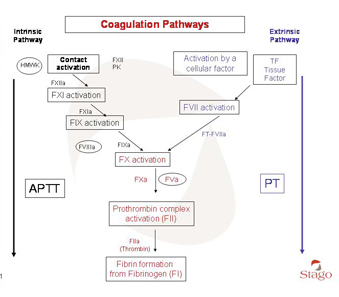Le informazioni fornite dal tempo di Quick e dal tempo di tromboplastina parziale attivata riguardano le cascate estrinseche e intrinseche indagate rispettivamente da questi due test e mostrate nella Figura 1.
Figura 1 = cascata coagulativa

Prolungamento del tempo di Quick e del tempo di tromboplastina parziale attivata e deficit di fattoris
Il prolungamento del tempo di Quick si verifica in caso di carenza di fattore I (fibrinogeno), fattore II (protrombina), fattore V (proconvertina), fattore VII (proaccelerina) o fattore X (fattore di Stuart).
Il prolungamento del tempo di tromboplastina parziale attivata indica la carenza del fattore I (fibrinogeno), del fattore II (protrombina), del fattore V (proconvertina), del fattore X (fattore di Stuart), del fattore VIII (fattore antiemofilico A), del fattore IX (fattore antiemofilico B), del fattore XI (fattore di Rosenthal) o del fattore XII (fattore di Hageman).
Il prolungamento dipende dalla sensibilità del reagente alle carenze dei fattori interessati. Inoltre, alcuni reagenti utilizzati per determinare il tempo di tromboplastina parziale attivata possono anche consentire di rilevare il deficit di due fattori coinvolti nella fase di contatto della coagulazione, la precallicreina (fattore di Fletcher) e il chininogeno ad alto peso molecolare, le cui carenze sono rare e non sono clinicamente evidenti.
Altre cause di prolungamento del tempo di Quick e del tempo di tromboplastina parziale attivata
Trattamento con eparina
L’aPTT è aumentato nei pazienti in terapia con eparina. Il prolungamento dell’aPTT dipende dal tipo di eparina utilizzata, dalla concentrazione di eparina in circolo e dal tempo di prelievo rispetto al momento della somministrazione dell’eparina.
I risultati dell’aPTT dipendono anche dalla sensibilità all’eparina del reagente utilizzato. Nello screening pre-chirurgico dell’emostasi è preferibile selezionare un reagente relativamente insensibile ad anticoagulante lupico circolante.
I reagenti utilizzati per determinare il tempo di Quick contengono un inibitore dell’eparina che li rende insensibili all’eparina fino a una specifica concentrazione circolante di quest’ultima sostanza.
La determinazione del tempo di trombina o la valutazione dell’attività anti-Xa possono fornire informazioni sulla presenza di un anticoagulante come l’eparina.
Presenza di un inibitore specifico diretto contro un fattore della coagulazione
Il prolungamento del tempo di Quick e dell’aPTT si verifica in presenza di un inibitore specifico diretto contro un fattore della coagulazione a cui uno di questi test è sensibile. La presenza di tale inibitore è rara (a parte nei pazienti trattati per l’emofilia). Alcuni inibitori, in particolare quelli specifici diretti contro il fattore VIII, comportano l’esposizione a un rischio emorragico esteso. La presentazione clinica può essere patognomonica e il rilevamento fortuito durante lo screening pre-chirurgico di routine è raro.
Lengthening of Quick's time and of APTT occurs in the presence of a specific inhibitor directed against a coagulation factor to which one of these tests is sensitive. Presence of such an inhibitor is rare (other than in patients treated for haemophilia). Certain inhibitors, particularly specific inhibitors directed against factor VIII, result in exposure to extensive haemorrhagic risk. The clinical presentation may be pathognomonic and fortuitous detection during routine pre-surgery screening is rare.
Trattamento con antagonisti della vitamina K
Il trattamento con antagonisti della vitamina K causa un deficit acquisito dei fattori della coagulazione dipendenti dalla vitamina K (fattori II, VII, IX e X), con conseguente prolungamento del tempo di Quick e dell’aPTT. Il grado di prolungamento, così come l’entità della carenza risultante, dipende dalla sensibilità del reagente al deficit di fattori di coagulazione indotto dai farmaci. Questa caratteristica costituisce il motivo per l’uso del tempo di Quick, o preferibilmente, della sua espressione tenendo conto sia del grado di deficit indotto sia della sensibilità del reagente, l’INR (International Normalized Ratio), per il monitoraggio e l’aggiustamento della terapia con antagonisti della vitamina K.
Trattamento con inibitori diretti
Il trattamento con inibitori diretti della trombina (argatroban, dabigatran, derivati dell’irudina) determina un prolungamento del tempo di Quick e dell’aPTT.
Il grado di prolungamento dipende dal farmaco somministrato e dalla sensibilità del reagente utilizzato, nonché dal tempo di prelievo rispetto al momento della somministrazione del farmaco. La determinazione del tempo di trombina può essere utilizzata per identificare la presenza di un inibitore diretto o indiretto (eparina) della trombina.
Trattamento con inibitori diretti del fattore X attivato
Il trattamento con inibitori diretti del fattore X attivato (rivaroxaban, apixaban) causa un prolungamento del tempo di Quick e dell’aPTT. Il grado di prolungamento dipende dal farmaco somministrato e dalla sensibilità del reagente utilizzato, nonché dal tempo di prelievo rispetto al momento della somministrazione del farmaco. La determinazione dell’attività anti-Xa può essere utilizzata per identificare la presenza di un inibitore diretto o indiretto (eparina) del fattore X attivato.
